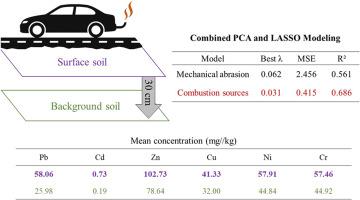道路几何和路边土壤污染的交通预测:来自PCA和LASSO模型的见解
IF 3.7
2区 环境科学与生态学
Q2 ENVIRONMENTAL SCIENCES
引用次数: 0
摘要
路边环境是交通系统与城市生态系统相交的关键界面,往往是潜在有毒元素(pte)积累的热点。在车辆老化和燃料质量令人担忧的干旱和半干旱地区,pte的持续和分散造成了更大的环境和公共健康风险。本研究旨在探讨伊朗伊斯法罕市西部路边土壤PTE (Pb、Cd、Zn、Cu、Ni、Cr)浓度的空间格局、潜在来源和环境驱动因素。从209个站点收集表面(0-2厘米)和背景(30厘米)土壤,并使用检测限为0.1至1.0 ppm的标准方案进行分析。主成分分析(PCA)确定了两个主要成分:PC1 (Zn, Cu, Cr)与机械磨损有关,PC2 (Pb, Cd, Ni)与燃烧源有关。最小绝对收缩选择算子(Least Absolute Shrinkage and Selection Operator, LASSO)回归和敏感性分析表明,PC1主要由道路坡度和曲率来预测,PC2由交通量和柴油车比例来解释(R2分别为0.561和0.686)。研究结果强调了结构和运营道路因素在塑造旱地城市PTE分布方面的双重作用,对快速城市化地区的土地利用规划和污染缓解具有影响。本文章由计算机程序翻译,如有差异,请以英文原文为准。

Road-geometry and traffic predictors of roadside soil contamination: Insights from PCA and LASSO modeling
Roadside environments are critical interfaces where transportation systems intersect with urban ecosystems, often acting as hotspots for the accumulation of potentially toxic elements (PTEs). In arid and semi-arid regions with aged vehicle fleets and fuel quality concerns, the persistence and dispersion of PTEs pose heightened environmental and public health risks. This study aimed to investigate the spatial patterns, potential sources, and environmental drivers of PTE concentrations (Pb, Cd, Zn, Cu, Ni, Cr) in roadside soils west of Isfahan City, Iran. Surface (0–2 cm) and background (30 cm) soils were collected from 209 stations, and analyzed using standard protocols with detection limits ranging from 0.1 to 1.0 ppm. Principal Component Analysis (PCA) identified two dominant components: PC1 (Zn, Cu, Cr) related to mechanical abrasion, and PC2 (Pb, Cd, Ni) linked to combustion sources. Least Absolute Shrinkage and Selection Operator (LASSO) regression and sensitivity analysis revealed that PC1 was primarily predicted by road slope and curvature, while PC2 was best explained by traffic volume and diesel vehicle proportion (R2 = 0.561 and 0.686, respectively). The results highlight the dual role of structural and operational road factors in shaping PTE distribution in dryland cities, with implications for land-use planning and pollution mitigation in rapidly urbanizing regions.
求助全文
通过发布文献求助,成功后即可免费获取论文全文。
去求助
来源期刊

Atmospheric Environment
环境科学-环境科学
CiteScore
9.40
自引率
8.00%
发文量
458
审稿时长
53 days
期刊介绍:
Atmospheric Environment has an open access mirror journal Atmospheric Environment: X, sharing the same aims and scope, editorial team, submission system and rigorous peer review.
Atmospheric Environment is the international journal for scientists in different disciplines related to atmospheric composition and its impacts. The journal publishes scientific articles with atmospheric relevance of emissions and depositions of gaseous and particulate compounds, chemical processes and physical effects in the atmosphere, as well as impacts of the changing atmospheric composition on human health, air quality, climate change, and ecosystems.
 求助内容:
求助内容: 应助结果提醒方式:
应助结果提醒方式:


